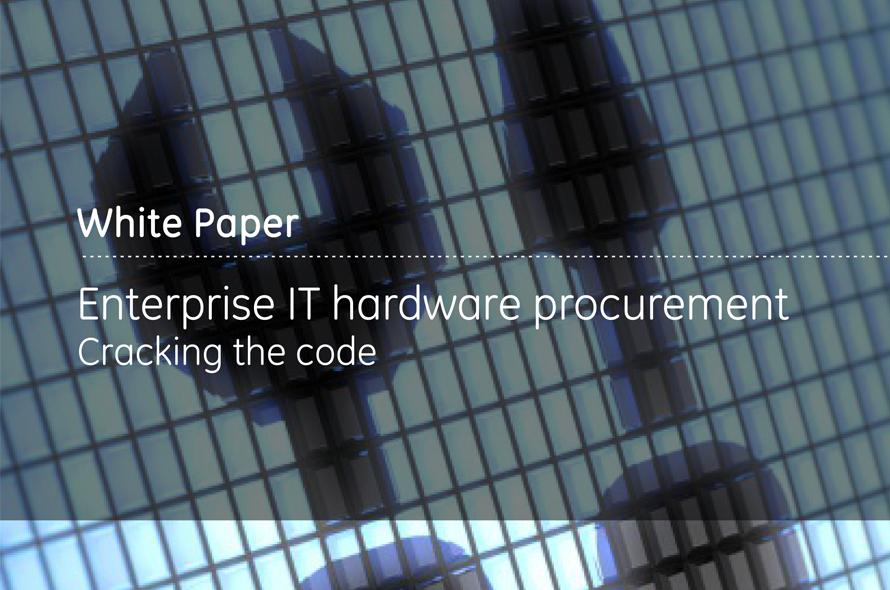Introduction
Rapid evolution of information technology demands the Enterprise IT Procurement function to consider new paradigms in sourcing hardware, especially the servers, PCs, and printers and peripherals. A holistic IT hardware procurement strategy that triangulates accurate demand planning, purchasing and ongoing service management costs while contributing to the environmental initiatives, will prepare companies to efficiently and cost-effectively use technology in the future.
GEP's work in the area of procurement of servers suggests that in order to maximize value, companies should take a long-term approach towards making data center capital investments. Specifically, companies should take into account the total lifetime cost of servers and extract uniform discounts for large implementations from suppliers with global reach. They also need to make significant improvements in forward planning of data center and server needs in order to get the most from capital investments in this area. For PC procurement, companies can leverage commoditization of PCs to decrease acquisition costs and adhere to three-year PC upgrade rates for optimizing support and out-of-warranty expenses. Companies should accurately assess demand for portable computing devices to constantly improve mobile workforce productivity. In the case of printer procurement, our experience suggests that companies should be disciplined about deploying managed print solutions with the right service levels and selecting environmentally friendly suppliers.
The white paper discusses best practices and provides market update on Enterprise IT Hardware Procurement.
Towards On-demand IT – Server Consolidation
Declining cost of server hardware over the years has sometimes led to a proliferation of boxes across locations. While the distributed server footprint aided rapid deployment of business applications suited to local markets and customers, it was often at the cost of compliance with enterprise architectural vision. The average enterprise utilization of server capacity is between 5 per cent and 40 per cent, leaving the remaining 60 per cent server capacity unutilized.
Moreover, peripheral costs such as power consumption have significantly increased over time. Energy-related expenditures account for about 12 per cent of the total costs of managing a data center. Cooling costs account for 50 per cent of the cos of purchase of a new server, which essentially means that it costs the same to cool as to compute.
The inefficiencies introduced by a distributed server environment eventually became a nightmare for CIOs. Server consolidation initiatives undertaken by companies were one of the first steps to reduce enterprise data center costs, infrastructure and labor. The cost efficiency brought in through server consolidation (Stage1, Exhibit 2) in terms of greater capacity utilization also reduced the carbon footprint through decreased power consumption. Consistent service levels, greater cost efficiency and lower data center footprint are clear drivers of physical server consolidation.
Growth in mission critical applications, which require high server performance and availability, together with universal access led to the development of server virtualization (Stage 2, Exhibit 2), as a result of which companies gain the advantage of provisioning a single global image and consistent operating system builds to enterprise users. While user mobility increases productivity of the workforce, from a cost management perspective, it introduces challenges in charge backs across different cost centers within the company. Private cloud deployment (Stage 3, Exhibit 2) addresses the challenges of charge backs by providing a platform for on-demand usage-based metering and results in integrating application stacks with virtual environment to further increase end user consistency.
The realized benefits of server consolidation are immediate. However, the exercise of enterprise server consolidation need not necessarily involve a radical migration of multiple low-end distributed servers into fewer centralized servers. This can be accomplished through set enterprise technology refresh cycles.
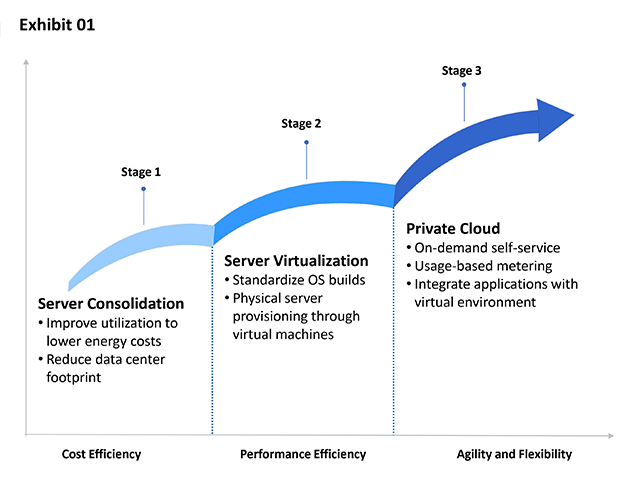
The evolution of demand-side drivers towards enterprise data center cost reduction measures has a direct impact on supply-side parameters. While innovation in semi-conductor manufacturing processes has kept pace with Moore's Law, movement of major server assembly units closer to semiconductor manufacturing bases has led to decreased supply chain costs.
Server sales have recovered after a dip in 2009, to post 18 per cent growth in 2010, though the growth is expected to ease to single digits from 2011. Blade servers continue to drive the growth of the server market, though the sales of virtualization servers are fast catching up to fulfil enterprise performance efficiency goals (Exhibit 3). Commoditization is affecting margins in many server verticals, especially x86 based low-end servers and a server is increasingly becoming just another small part of an overall data center solution, rather than a standalone device.
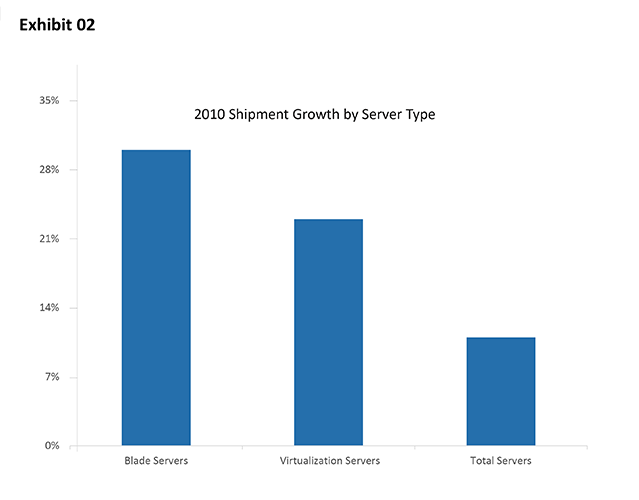
Sourcing Strategies
In developing a technology roadmap, evaluation of total cost of computing, networking and storing is essential as the market will see an increasing number of integrated unified solutions. Considering the changing demand-side and supply-side dynamics, adopting meticulous sourcing strategies by having a good supplier mix, negotiating on labor charges, evaluating non-traditional approaches such as outsourced infrastructure and ensuring rate consistency in global implementations would result in cost advantages to companies.
From the earlier metric of price to performance ratio, the model has shifted to include many more parameters, including storage scalability, virtualization capability, power efficiency and heat characteristics. Server procurement is no longer a standalone activity as it has changed from buying servers to buying unified solutions -- a unified bundle consisting of servers, networking and storage devices and services.
Global reach is still an issue for manufacturers and that can significantly increase support expenses. However, third parties can provide services at a fraction of the manufacturers' cost and, as such, they should be considered as a part of the supplier mix when evaluating server sourcing. Turnkey implementations within server maintenance and server consolidation initiatives are rare, because of the zero downtime requirements. Typically, the price quoted by the suppliers is towards implementation in working hours. Overtime charges are critical hidden charges within supplier/reseller pricing, which should be negotiated in advance. Overtime charges can potentially increase installation and maintenance costs to more than 150 per cent of the initial estimates.
In large scale global implementations, a single global team is beneficial for bringing in design and implementation consistency across the globe, though the travel costs need to be appropriately negotiated.
Outsourcing has become a viable option to consider – unlike client virtualization, server virtualization can directly reduce server costs. As data center companies develop higher economies of scale, periodic evaluation of inhouse versus out-sourced solutions is necessary. Customers increasingly want solutions, rather than servers. High speed networks are also enabling server hosting to be outsourced to dedicated data center companies, reducing the need for customers to buy their own servers. The focus on storage systems is increasing rapidly, as more data is hosted in the cloud.
RISC servers have been assigned legacy status. For customers locked into RISC servers, the price differential of x86 servers is likely to increase and IT infrastructure overhaul will have to be considered. Appropriately timing the procurement can capture additional savings from sourcing, considering that the best value for a server is obtained in the last six months of its processor life cycle. Key drivers for the purchase of a server should be segmented into storage vs. computing applications, as storage-only solutions are distinctly more cost- effective. Large unit orders typically fetch further discounts over negotiated contracts. Companies should consolidate and leverage order volumes to benefit from further discounts.
In global deals, it is critical to get uniform discounts across the globe, rather than volume-based discounts at a particular geography. Most resellers do not have a presence in all geographies across the globe. Therefore, considering the scope of enterprise implementation, it is recommended that the reseller should ensure adherence to the initially contracted rates.
Enterprise PC – Evolution Towards Mobility

Better, cheaper, faster and lighter – PCs have evolved through constant innovation. The industry has transformed from being a set of continuous flow manufacturing companies to a job shop, catering to individualized preferences on weight, mobility and feature set. An average year-on-year decline of nearly 14 per cent in PC prices over the past decade has made them more affordable, transforming them into consumer goods, rather than specialized corporate computing equipment. The worldwide market share of consumer PC purchases experienced a tremendous growth from 40 per cent in 2006 to more than 54 per cent in 2010, and is projected to go up to 60 per cent by the year 2014. While this commoditization of PCs has benefited companies in procuring standard PCs at lower prices, the trend has severely dented supplier margins. Large suppliers have, therefore, started diversifying their offering from being just PC manufacturers to services and storage servers so as to sustain and grow their margins. Therefore, PC procurement is no longer limited to purchase of the best equipment at the lowest possible cost. The total cost of purchase, accounting for bundled services and life cycle management costs of PCs as an asset, should be a key consideration in choosing the right supplier.
The financial crisis of 2009 resulted in a direct downward impact on corporate IT budgets. As companies became more cost conscious, value from every support dollar on existing investments was measured and evaluated. In companies where the PC upgrade was unavoidable, the option to lease rather than buy outright gained prominence. As the economic scenario recovered from low business sentiment in 2010, companies started relooking at technology investments. The launch of Windows 7 in 2009 and innovation from Intel, along with availability of corporate IT budgets, have driven enterprise demand for PC equipment in 2010. Large enterprises accounted for a growth of 22.4 per cent for desktops and 31.7 per cent for portable PCs. Increased productivity benefits of over 15 per cent offered by portable PCs in enterprises are driving more companies towards adopting new portable form factors, such as tablets.
Mobility is further anticipated to increase in line with the desire of companies to extract greater workforce productivity. Availability of different form factors, other than just the traditional notebooks and desktops, has led to greater diversity of choices for companies to select devices based on usability and user sophistication. As the consumer market sways towards nontraditional form factors, the demand for standard notebooks and desktops will reduce. A majority of companies are taking advantage of this lowered demand for desktops and notebooks and gaining price discounts from suppliers.
Companies want higher processing power, rather than just the convenience of workforce mobility. Form factors such as NetBooks (mini-notebooks) could be neither positioned as convenience devices nor as high performance computing devices and quickly lost market share to the traditional, but lighter, notebooks and new-age tablet devices. As major PC suppliers tried to improve their operating margins through cost efficiencies, Apple significantly gained through investments in innovation. The introduction of the iPad drove sales of tablets, while Apple gained the first-mover advantage through premium pricing. Tablets are not new to the industry, however, Apple capitalized on the concept by introducing sophisticated design and convenience into a market mix of traditional devices.
Though tablet PCs are attractive options because of enhanced mobility, concerns about interoperability will prevail. The computing power of tablet PCs is yet to reach enterprise thresholds to effectively support heavy enterprise system applications. Therefore, in the interim, tablet PCs such as iPads will still be used as “third- home” devices and as complements to notebooks rather than their replacements.
With a deluge of form factors by the top suppliers, a new trend has started taking CIO mindshare. Use of personal devices in corporate networks is beneficial in terms of offering users the ease of having access from anywhere. However, the trend is fraught with concerns about security and support costs. Virtualized desktop infrastructure would potentially offer a solution to overcome these concerns. Desktop virtualization enables enterprises to gain a handle on infrastructure consolidation and application management through centralized management and reduced operational costs of about 20 per cent. One of the key reasons for companies to adopt virtualized desktop infrastructure is reduced higher capital costs on the purchase of desktop/laptop PCs. Microsoft has placed its bet on VDI as a future trend by extending virtualization features in Windows 7 through VDI Suites and Remote Desktop services. Though the adoption is higher in mid-size firms, overall, only 18 per cent of the large enterprises are considering implementation of VDI. Enterprises would gain by adopting VDI as an enterprise technology strategy if innovation enables users to work when disconnected from the network and reduce the risks from single point failure.
Sourcing Strategies
The key to driving costs down is to make an accurate assessment of demand. Demand assessment is easier in case of turnkey implementations at a single geography. The complexity increases when PC upgrades take place over a period of time, based on end-oflife assessment of the equipment and with an added complexity of a global rollout. A single repository of PC asset information across all company locations is a good investment to gain significant cost savings over the years. Therefore, companies should negotiate with suppliers and have asset tracking included in the bundled PC offering. The long-term benefits of this measure for companies which are in a nascent stage of gaining control over enterprise IT equipment costs is tremendous.
The PC supplier industry is highly consolidated, with the top-five suppliers accounting for more than 50 per cent of the market share (Exhibit 5). Despite low supplier density, a greater consumer share sets a downward trend in price differential. Companies should leverage commoditization of the PC equipment across suppliers and use e-auctions to get the best value from PC upgrades. It has also been observed that the best available configuration in the market may not necessarily be the optimal configuration for enterprise needs. To assess configuration, processor class has come to be the criterion, rather than processor speed. Companies should carefully design lot strategy (lotting) in e-auctions to leverage maximum buyer power. Rank order auction format on equipment-based lots would be a recommended auction strategy to eliminate regional price differentials.
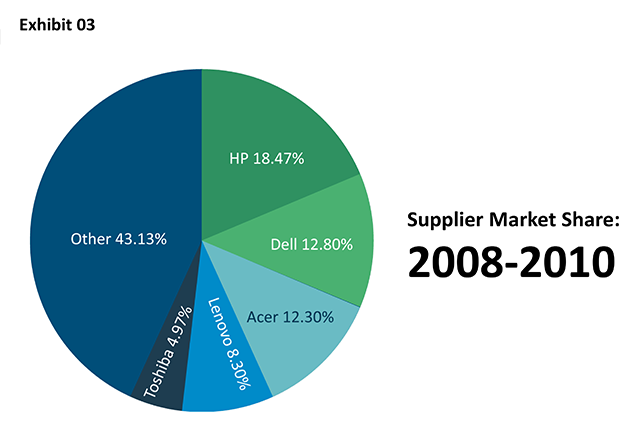
Exhibit 6 shows a typical total cost curve for large enterprises on PC costs. As can be observed, beyond a three-year timeframe, the support costs and out-of-warranty repair costs exceed the cost of new PCs. Apart from support and out-of warranty costs, companies should evaluate the below factors related to productivity improvements, security incidents and energy consumption in determining the time for PC upgrades:
- The cost of productivity loss and user downtime from machines older than three years increase the costs beyond maintenance and support costs.
- Security incidents in older systems are one of the key maintenance cost drivers – a four-year old PC has 53 per cent more security incidents than a PC in its first year.
- New PCs consume significantly less power than older PCs, therefore companies would also benefit from cost savings through lowered power consumption; they can also contribute to corporate green initiatives by going in for a three-year upgrade cycle.
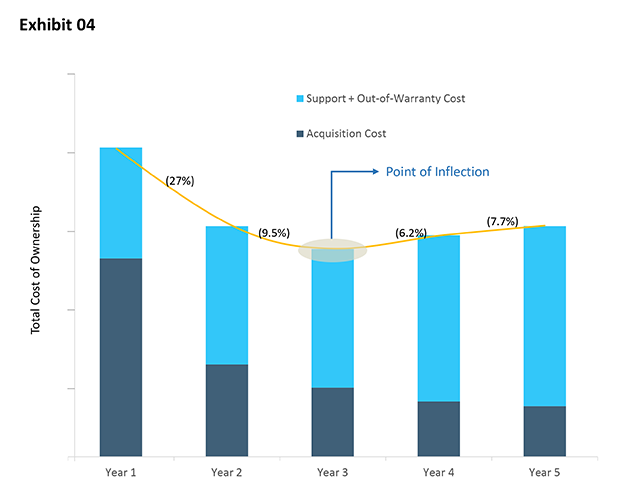
Low margins of PC manufacturers are making diversification a strategic imperative for suppliers. While supplier revenues were up in 2010, the unit price of PC equipment continues to decrease through the years. With falling margins, suppliers are now looking at virtualization and cloud computing paradigms as the next envelope of technology evolution. HP's purchase of 3PAR and Palm, and Dell's acquisition of Bhoomi are good indicators of a move towards virtualization and cloud computing. Based on enterprise technology strategy, companies should negotiate on the total solution (maintenance and software, bundled with the offered PC hardware) rather than look at PC refresh as a technology replacement. Typically, training and switching efforts are offered at significantly lower prices by non-incumbent suppliers in PC upgrade cycles.
Printers and Peripherals
Ubiquitous access to information through proliferation of portable PCs and smartphone devices has not reduced demand for printers. A printer has, instead, transformed into a mini-processing unit rather than a plain output device. Integration of printers with corporate document management systems, and the ability to convert scanned documents into editable documents through optical character recognition software has given rise to a new breed of multi-functional printing devices. With greater focus on reducing the impact on environment in terms of power consumption, use of recycled paper and reduction in paper consumption, companies are constantly evaluating cost control measures. There is a heightened focus on capturing costs per employee to enable charge-backs of printing costs to departments within companies. Information security needs in certain companies are further driving the demand for smart MFPs (multi-function printer) which provide printing capabilities through security features integrated with corporate security systems.
Overall, the market for printers has recovered to 2008 levels after a steep dip in 2009, with over 120 million printers shipped worldwide. The highest market share is held by Inkjet, with over 66 per cent of the market share, while laser printers hold a mere 20 per cent of the market in terms of units shipped. However, laser printers form about 80 per cent of printer revenues as each unit is significantly more expensive than inkjet printers. Multi-Function Printers/Devices are new age machines with a high enterprise adoption. These are all in one devices, enabling users to print, copy, scan, as well as fax. The integration of MFPs with corporate security systems has almost eliminated the need to have personal printers, even in confidential functions such as HR.
With emerging trends in technology, the worldwide printer market is projected to decline until 2014. Decrease in prices of color printing will result in color laser printing devices cannibalizing sales of monochrome laser printers.
The market is dominated by a few top vendors competing aggressively for market share. As switching costs are low, the price and feature set become key supplier differentials. Printer OEM decision is not a critical factor for most procurement organizations, so the reseller and price point plays a critical role. Small-format MFP (multi- functionality printer) adoption is showing strong growth, while the large format is stagnant. A greater number of companies wants to keep a tight control on printing expenses and is, therefore, opting for MPS (managed printing services). This helps companies effectively plan their printer infrastructure and also ensures greater compliance with the green agenda. Typical companies making the switch to managed print solutions average employee-toprinter ratio of 1:3 initially. Exhibit 7 lists a few benefits that companies gain by using Managed Printing Services.
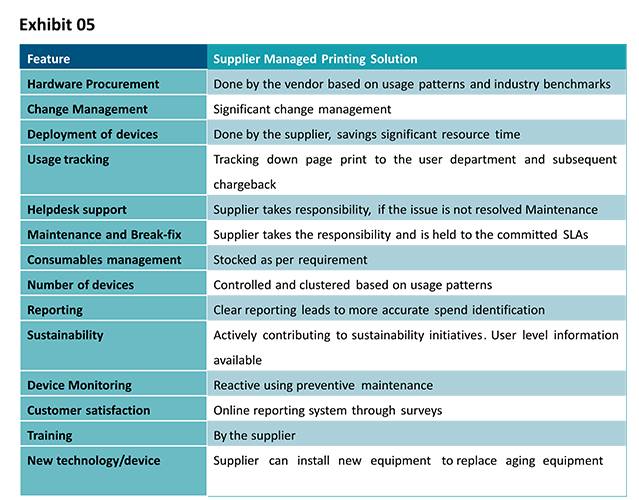
Sourcing Strategies
The acquisition cost of printing equipment is very low, compared to the total cost of operation, which is difficult to accurately project at the time of strategic sourcing. Companies should, therefore, evaluate managed print services as an option, as that can provide planning flexibility and good return on investment. MPS also eases vendor management through well-defined SLAs. Though the price per page through managed printing services can seem high, th all-inclusive total cost of the existing solutions should be evaluated to make the right decision in selecting MPS.
Printing uses large quantities of consumables and, as a result, is environmentally sensitive. The cheapest printing technologies may not be the most eco-friendly. Therefore, companies should ensure that the selected supplier has the right environmental credentials and a green roadmap.
Printers alone are rarely sourced in isolation, and the decision is often influenced by who the reseller is, and who wins the primary PC hardware contract, amongst others. Unless there is an additional discount on offer, there is no synergy in using the same brand for printers as for PC hardware. Companies should, therefore, focus on selecting the most cost-effective solution.
Finally, cost-savings in printing can come as much from setting up the right availability and access levels, as from negotiating with external parties. Proper demand and access management to identify the exact number of assets required globally should be performed and companies should have appropriate access rights management to prevent overuse/misuse.
Companies are innovating the way they procure direct and indirect materials. IT is a critical enabler of the way companies do business. Capital investments in IT, comprising hardware, can account for a sizeable portion of companies' indirect spend and operating expense. Therefore, it is crucial for companies to continue making improvements in the way they buy IT hardware.

